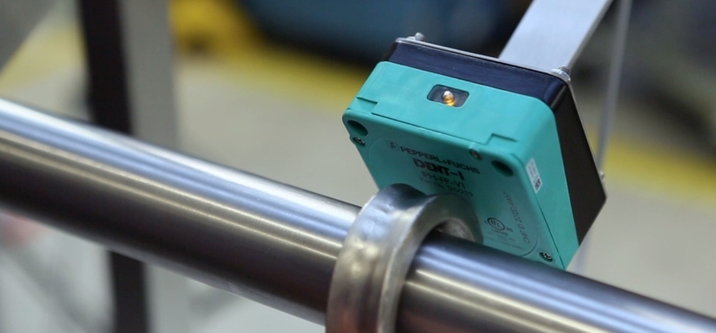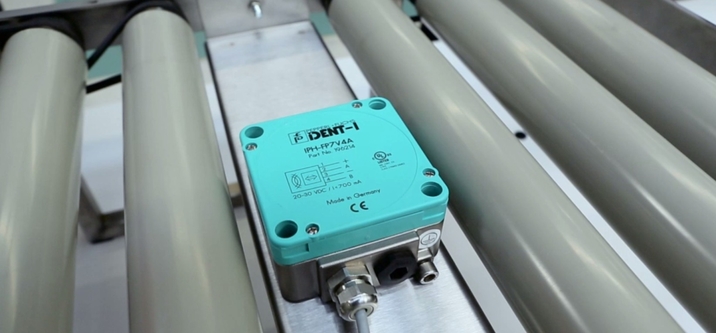RFID for Food Tracing in Meat Processing Plants
The safety and traceability of food is an increasingly relevant topic for producers, suppliers, and end consumers alike. Regulations like the European Union’s EC 178/2002 or the United States Department of Agriculture’s 9 CFR lay down binding food safety procedures for members. However, an area where these regulations are not extensively focused is internal traceability. At this stage of production, significant safety advantages are possible. These include the ability to collect more data that will enable substantial improvements in process control and stock management as well as more targeted and precise recall campaigns.

Conveyor hooks transport larger meat cuts in the slaughterhouse. RFID transponders are flush mounted into the conveyor hooks and carry data on the respective animal.
The application
One of the world’s leading meat processing companies, located in Europe, has realized the full traceability of meat processing in their production plants using Pepperl+Fuchs' RFID technology. At their central pork processing site alone, up to 90,000 pigs can be processed per week. A conveyor system transports the animals, where a transponder is integrated into each of the conveying hooks. This allows definite identification along the whole production chain.
The RFID system must be able to withstand extreme temperature ranges from -30 °C to +140 °C that occur throughout the process. In addition to meeting the requirements on intended moving speed and reading distances, the transponders should achieve a minimum service life of five years while the reading devices must be able to withstand the harsh environments found in the food industry.
The goal
With unique information stored on the RFID transponders, product-related data is collected and documented at every processing point. Some of the data that needs to be collected covers weight, size, thickness of the layer of fat, and of course the upstream supplier. Linked to this information are the results of veterinary tests. Throughout the process, this data is consistently associated with a specific animal.

Inside the slaughterhouse, RFID heads are mounted into roller conveyors. Here, they identify plastic boxes that are equipped with RFID transponders and transport meat cuts.
The solution
After defining the customer’s requirements, a low-frequency RFID system was chosen. IPC02-16 and IPC11-12 transponders were flush mounted into the metal of the conveyor hooks. In a second application within the plant, these transponders are used on Christmas trees—racks that are used to deliver pieces of meat in cooling trucks. Here, the transponders are used as clips that can be detached from the respective Christmas tree right before shipping and then used again. The third location where RFID transponders are utilized is on the plastic transport boxes that travel on roller conveyors. They transport the single meat cuts to additional processing points and are equipped with IPC11-50CD transponders. These transponders are embedded in the bottom of the box and can be read at a distance up to 80 mm.
When it comes to reading information, IPT-FP RFID read heads were used. Pepperl+Fuchs offers enclosures for these devices that are made of corrosion-resistant steel and are especially suitable for the harsh requirements of the meat processing industry. Initially, PROFIBUS was used as the interface. Over time, the process changed to a PROFINET interface. As Pepperl+Fuchs offers products that interface with all common industrial fieldbus types and communication protocols, this was no problem. Today, IPH-FP7V4A RFID read/write heads in combination with the IDENTControl interface unit are being applied as well.
For optimum flexibility, Pepperl+Fuchs supplied handheld readers that can be programmed using JavaScript and read the specific data formats properly. The 40-bit programmable transponders allow the customer to write custom codes to each tag. Or, with the OTP function (One Time Programmable) a quasi fixcode can be generated which cannot be changed. The handheld readers can be configured specifically to meet these requirements.

Pepperl+Fuchs' wide RFID portfolio enables high performance identification solutions for the meat processing industry.
The benefits
The setup of RFID technology provided by Pepperl+Fuchs offers compelling advantages for food tracking and tracing in meat production facilities, as it allows fully automated noncontact detection along the entire process chain. The transponders are resistant to contamination and survive large temperature fluctuations as well as changes in humidity. Thus, this identification technology is largely maintenance-free. RFID transponders also offer the opportunity during the process to receive and store information. Since they are passive elements, no additional power supply is needed. Today, the customer runs 600 identification systems and 30,000 RFID transponders in their central processing plant—enabling a fully automated and safe internal tracking and tracing of meat.
At a glance
- Extremely robust and noncontact identification technology
- Designed for the special requirements of the meat processing industry
- Enables the fulfillment of legal requirements for food safety and traceability
- Automates and streamlines error-free data acquisition in production processes
- Increases productivity and plant availability
- Secure industry-standard connectors and cables (fieldbus and other industry interfaces)








 +61 3 9358 3400
+61 3 9358 3400